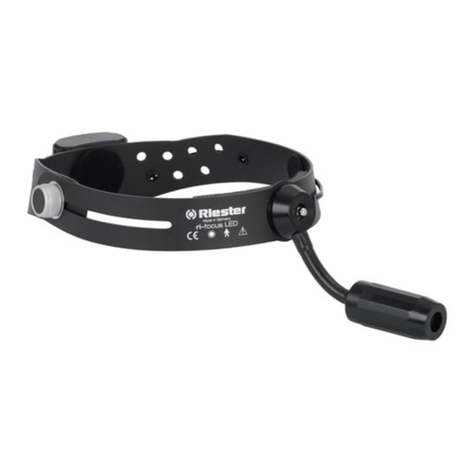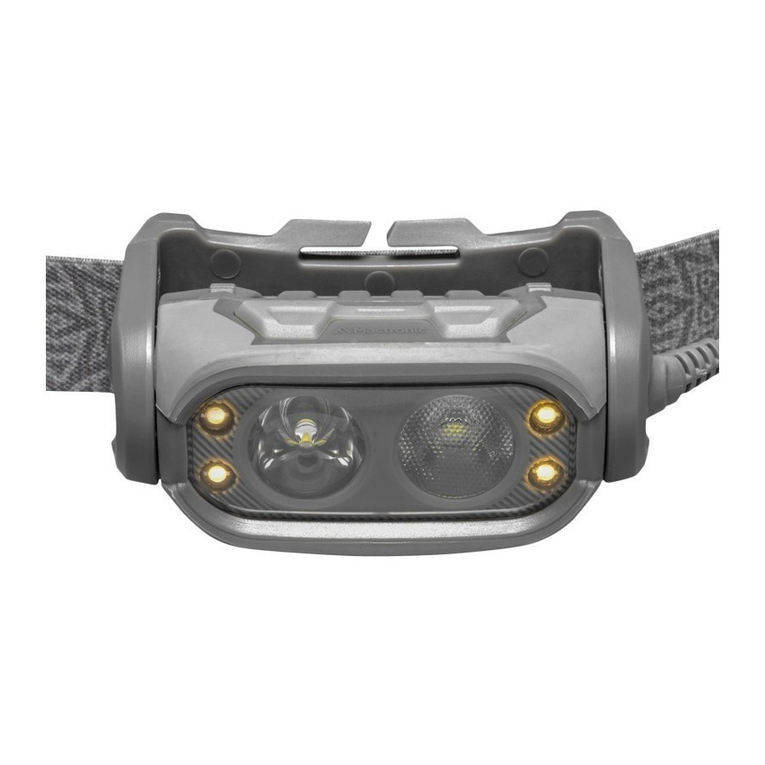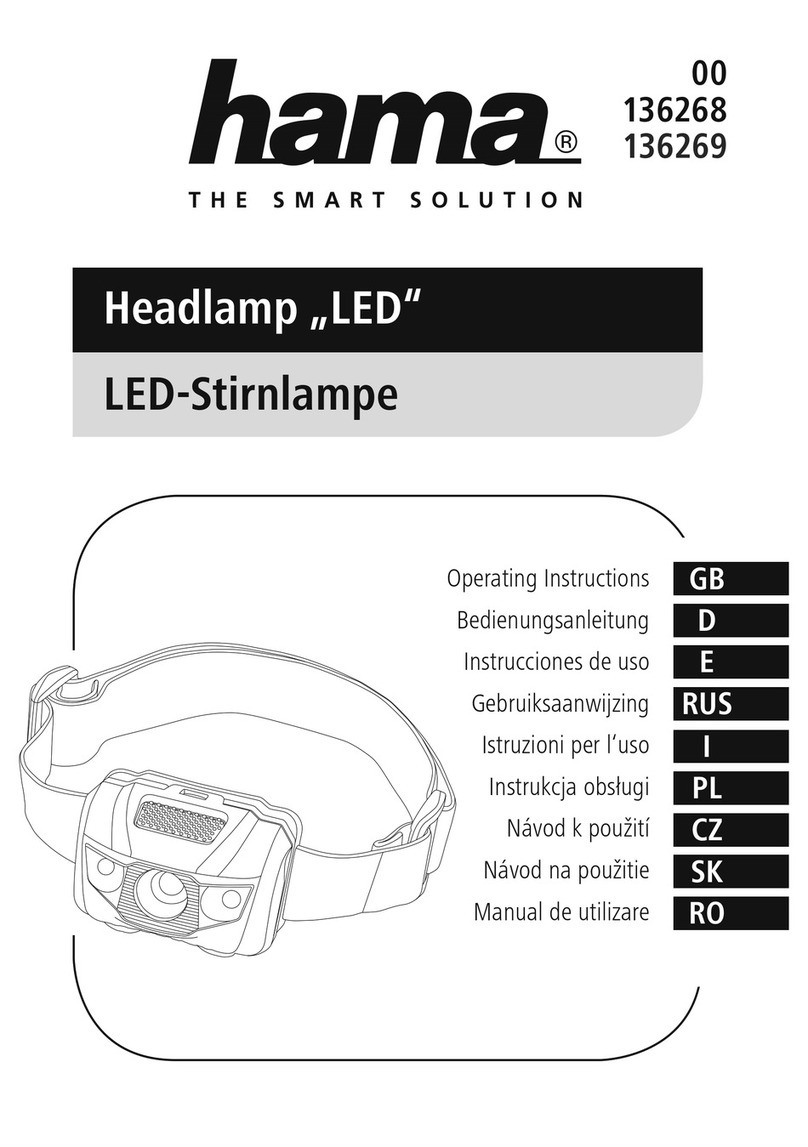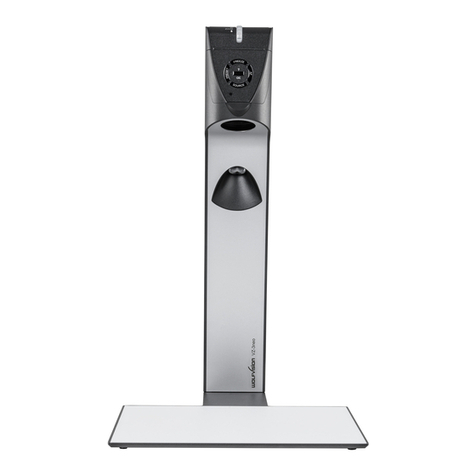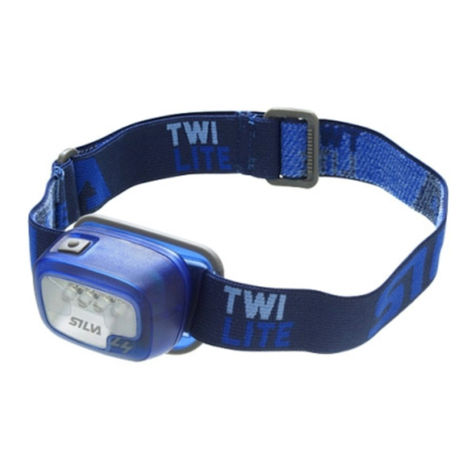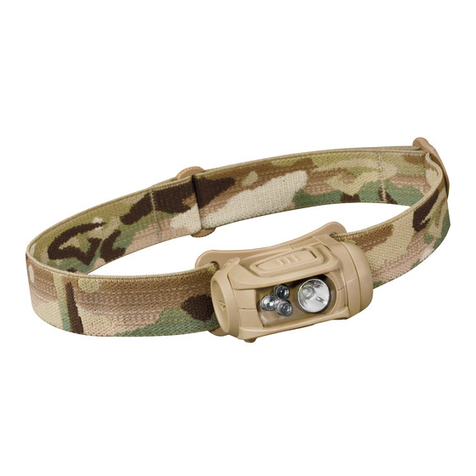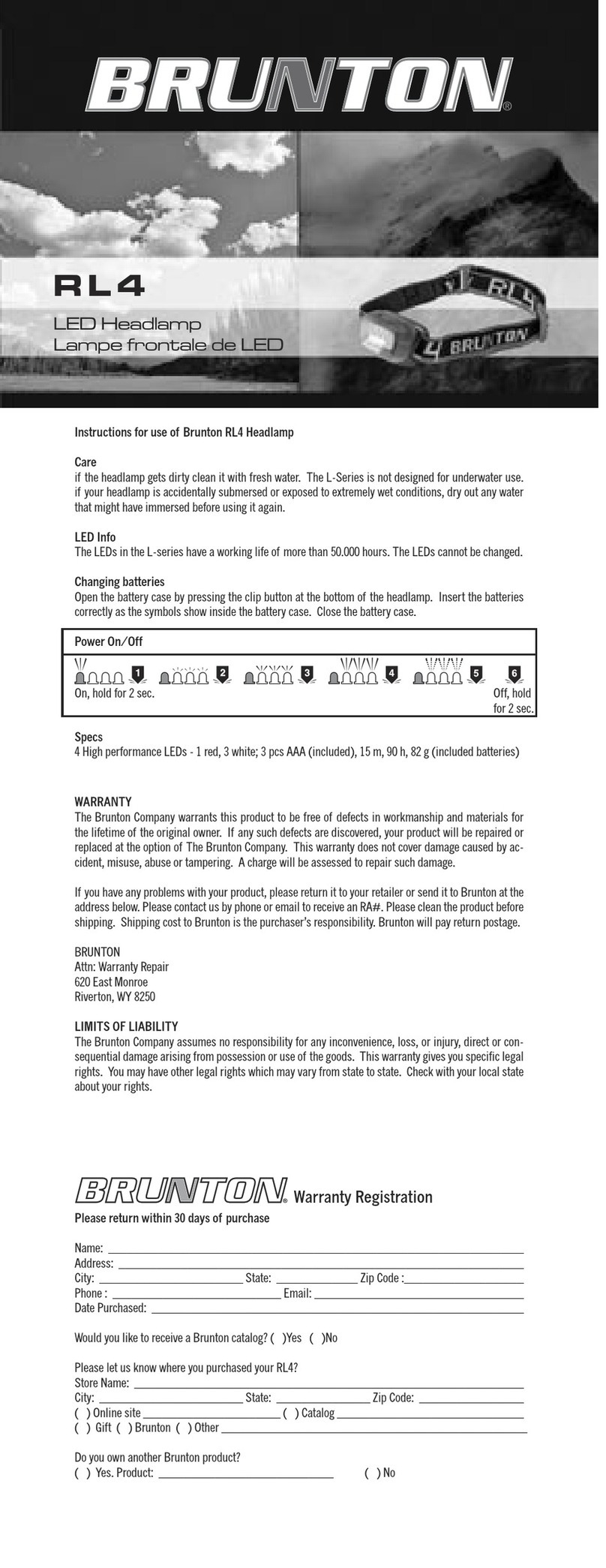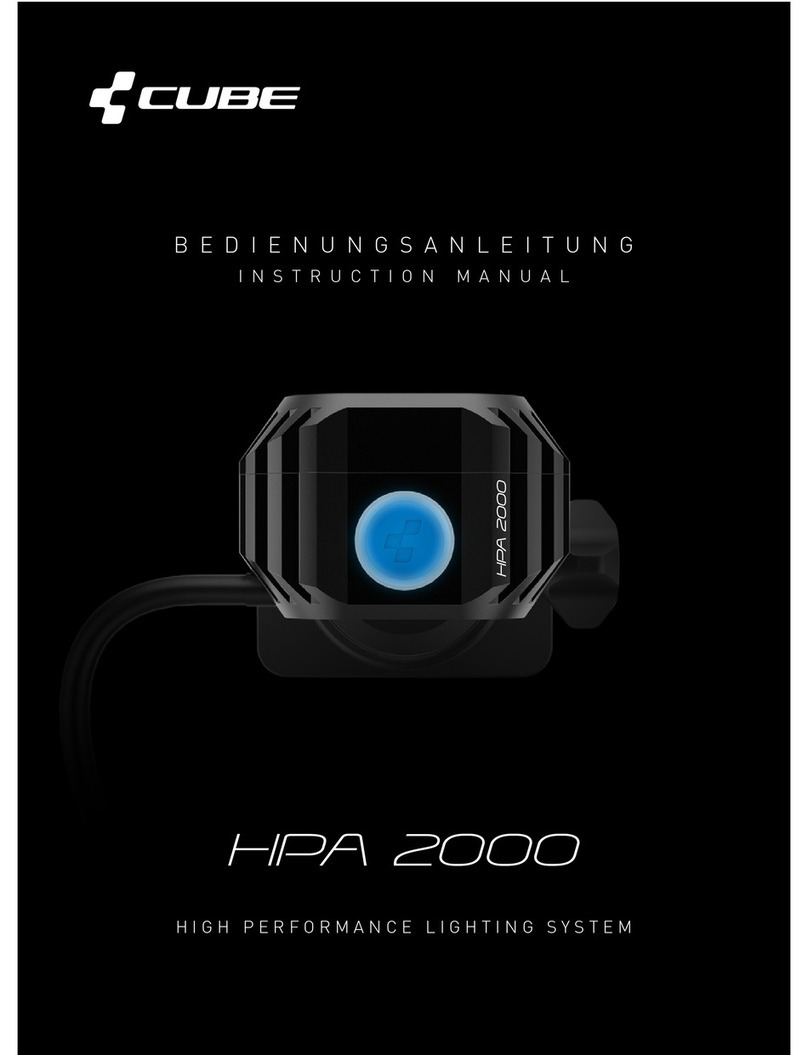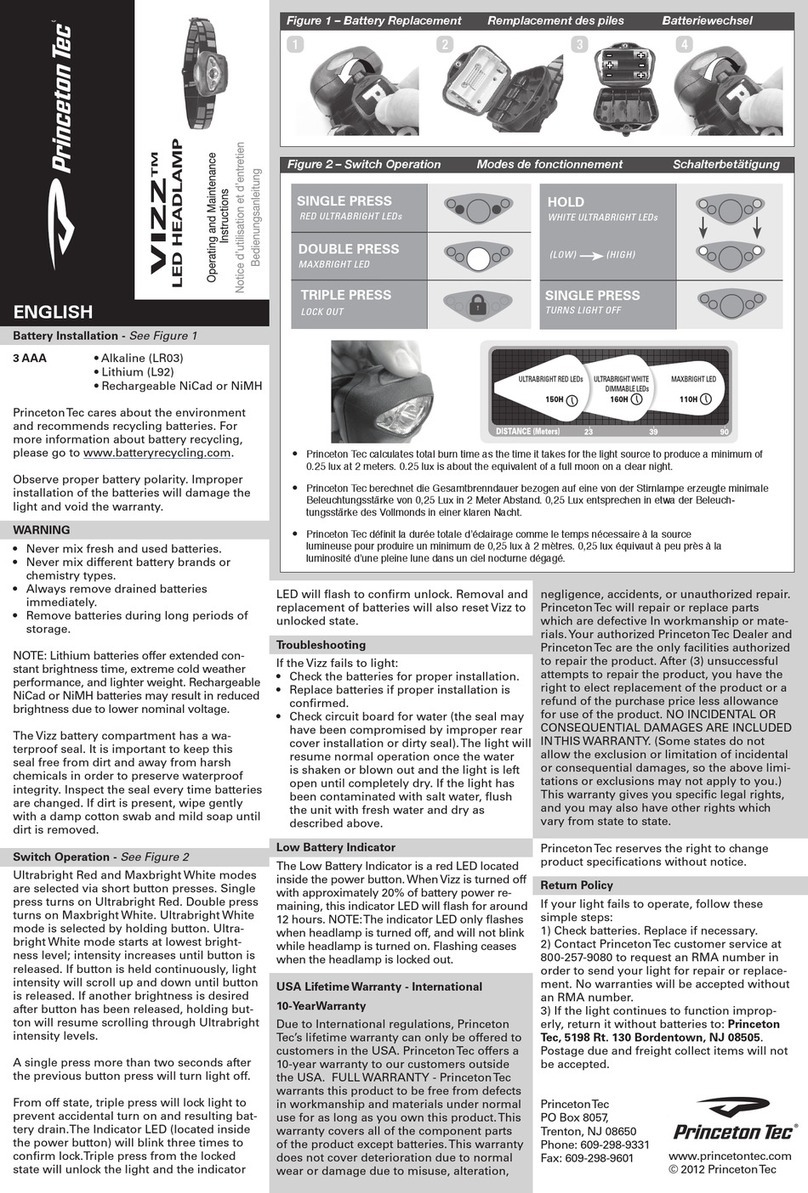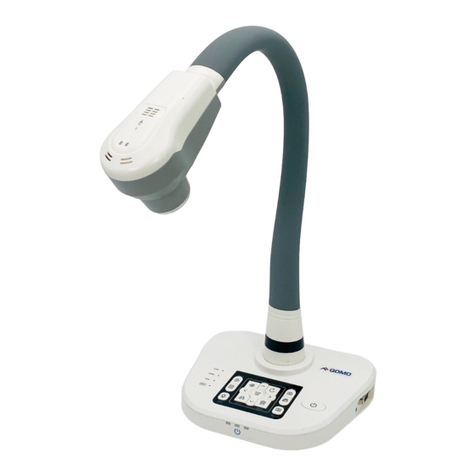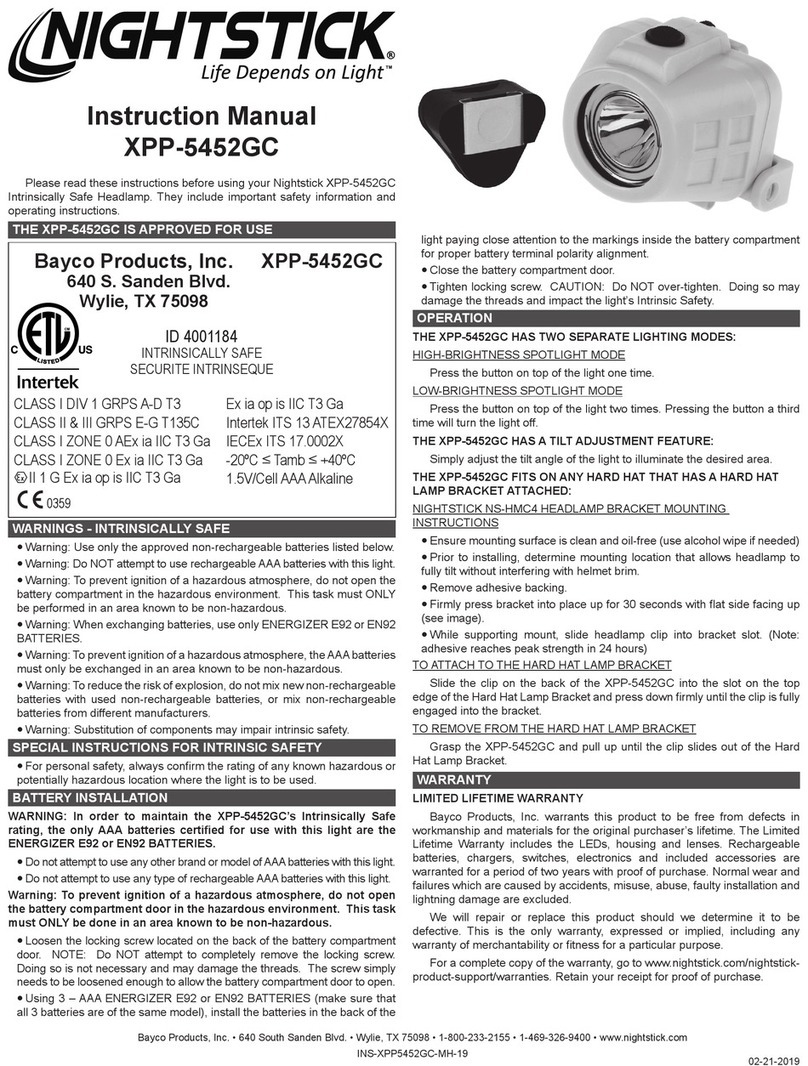Riester 6090 User manual

Gebrauchsanweisung
Stirnspiegel und Stirnlampen
Instructions
Head mirrors and head lamps
Mode d’ emploi
Miroirs frontaux et lampes frontales
Instrucciones para el uso
Lámpas frontales y espejos frontales
Инструкция по эксплуатации
Налобные зеркала и налобные осветители
Istruzioni per I’ uso
Lampade frontali e specchi frontali
all models

2
Table of Contents
1. Introduction
1.1 Important information prior to use
1.2 Safety symbols
1.3 Packaging symbols
1.4 Intended use
1.4.1 Indication
1.4.2 Contraindication
1.4.3 Intended patient population
1.4.4 Intended operators/users
1.4.5 Required skills/operator training
1.4.6 Environmental conditions
1.5 Warnings/caution
1.6 User responsibility
1.7 Scope of delivery
2 First use of the device
2.1 Purpose
2.2 Preparing headlights and head mirrors for use
2.3 Use and function
2.3.1 Adjusting the headband
2.3.2 Adjusting the ri-focus® lamp head LED
2.3.3 Inserting the (rechargeable) batteries into the ri-focus® LED and clar N
2.3.4 Powering the ri-focus® LED and clar N on and off.
2.3.5 Battery compartment cover
2.3.6 Focusing the ri-focus® LED
2.3.7 Replacing the headlight/head mirror
2.3.8 Replacing the bulb
2.3.9 Using the charger
2.3.10 Technical specifications
2.3.11 Replacing the headband padding
2.3.12 Care instructions
3 Spare parts
4 Technical specifications
5 Maintenance
6 Disposal
7 Disposal of packaging
8 Accompanying documents on electromagnetic compatibility according to IEC 60601-1-2
8.1 EMC (electromagnetic compatibility)
8.2 Disposal
9 Warranty
1 Introduction
1.1 Important information prior to use.
You have purchased a high-quality Riester product, which has been manufactured in compliance with Directive (EU) 2017/75 and is subject to the strictest quality cont-
rols at all times. Read these instructions for use (IFU) carefully before using the device and keep them in a safe place. If you have any questions, we are available at any
time, and our contact information is provided at the end of this IFU. Contact information for distribution and sales partners can be obtained up on request. Please note
all instruments described in these instructions for use may only be used by appropriately trained personnel. The safe functioning of this device is only be guaranteed
if Riester original parts and accessories are used.

3
Symbol Note on symbol
Follow instructions in the user manual.
Type B applied part
MD Medical Device
Class II protective devices
Warning!
The general warning symbol indicates a potentially dangerous situation that can lead to serious injuries.
Caution!
Important note in this manual.
The caution symbol indicates a potentially dangerous situation that can lead to minor or moderate injuries. It can also be used to warn of unsafe practices
Attention: Do not look into the beam
LED lamp
Do not look into the beam
Class 2 LED
Do not use outdoors
Direct Current (DC)
Alternating current
Manufacturing date
YYMMDD (year, month, day)
Manufacturer
Manufacturer‘s serial number
Lot/batch number
REF Reference number
°C °F Temperature for transportation and storage
Relative Humidity for transport and storage condition
Air pressure for transportation and storage
Operating ambient air pressure
CE marking
Symbol for the marking of electrical and electronic equipment in accordance with Directive 2002/96/EC.
Caution: Used electrical and electronic equipment should not be treated as normal household waste, but should be disposed of separately in accor-
dance with national and EU regulations.
Non-ionizing radiation
1.2. Safety symbols

4
Symbol Note on symbol
Indicates that the contents of the transport package are fragile and should therefore be handled with care.
Store in a dry place
Indicates the correct position for transporting the package.
Keep away from sunlight
"Green Dot" (country-specific)
1.3 Packaging symbols
Notes on electromagnetic compatibility
There are currently no indications that electromagnetic interactions with other devices can occur when the devices are used as intended.
Nevertheless, under the increased influence of unfavourable field strengths, e.g. during the operation of wireless telephones or radiological instruments, disturban-
ces cannot be completely excluded.
Warning:
The use of other accessories may result in increased electromagnetic emissions or reduced electromagnetic imm¬unity of the device and lead to incorrect operation.
The electromagnetic compatibility of this device has been verified by tests according to the requirements of IEC 60601-1-2.
1.4 Intended Use
Riester headlights and head mirrors are manufactured for the illumination of body parts under examination.
These products are most often used in hospitals or medical practices by a trained doctors or specialists. It is an active diagnostic medical device/ME device operation
is dependant on an internal power source.
Intended use:
The LED examination lamps serve as a light source for the detection, diagnosis, monitoring, treatment or alleviation of diseases, injuries or disabilities. These pro-
ducts are most often used in hospitals or medical practices, etc.
The examination lamps are not intended for eye exams and should not be used for such.
1.4.1 Indication
The LED headlights and head mirrors clinicians in diagnostic examinations and surgical interventions. The light source used, a 6 V LED or 6 V vacuum lamp, is powe-
red by a battery compartment.
The examination lamps assist the trained doctor or specialist in the detection, diagnosis, monitoring, treatment or alleviation of illnesses, injuries and disabilities.
1.4.2 Contraindication
There may be a risk of ignition of gases if the instrument is operated in the presence of flammable mixtures or mixtures of pharmaceuticals.
The examination lamps must never be placed in liquids.
Only use Riester or Riester-approved accessories/consumables.
Cleaning frequency and sequence must comply with the cleaning regulations of non-sterile products in the respective facility.
Cleaning/disinfection instructions must be observed.
The product may only be used by trained personnel.
1.4.3 Intended patient population
The device is intended for use on adults and children.
1.4.4 Intended operators/users
The examination lamps are intended exclusively for use by doctors and clinicians (trained medical professionals) in clinics and medical practices.

5
1.4.5 Required skills/operator training
Only trained medical professionals should operate the examination lamps, as they have the required skills and qualifications.
1.4.6 Environmental conditions
The device is intended for use in rooms with a controlled environment.
The device must not be exposed to adverse/harsh environmental conditions.
1.5 Warnings/caution
Warning
The general warning symbol indicates a potentially dangerous situation that can lead to serious injuries.
Do not use in a magnetic resonance environment!
There is a risk of ignition of gases if the device is operated in the presence of flammable mixtures or mixtures of medicinal products and air or oxygen or nitrous
oxide! The device must not be operated in rooms in which flammable mixtures or mixtures of pharmaceuticals and air or oxygen or nitrous oxide are present, e.g.
operating rooms.
Electric shock!
The housing of the examination lights may only be opened by authorized persons.
Damage to the device due to a fall or strong ESD influence!
If the device is not functioning, it must be returned to the manufacturer for repair.
The device must be used in a controlled environment.
The device must not be exposed to harsh environmental conditions.
Caution!
The caution symbol indicates a potentially dangerous situation that can lead to minor or moderate injuries. It can also be used to warn of unsafe practices.
The faultless and safe functioning of these examination lamps can only be guaranteed if Riester original parts and accessories are used.
Old electronic devices must be disposed of in accordance with the institutional guidelines for the disposal of expired devices.
Cleaning frequency and sequence must comply with the cleaning regulations of non-sterile products in the respective facility. Cleaning/disinfection instructions in
the instructions for use must be observed.
We recommend unplugging the charger before cleaning or disinfecting.
Clean and disinfect the examination lamps carefully so that no liquid penetrates the interior.
Never place the examination lamps in liquids! The examination lamps are delivered in a non-sterile condition. Do not use ethylene, oxide gas, heat, autoclaves or any
other harsh methods to sterilize the device. The devices have not been approved for mechanical reprocessing or sterilization. This leads to irreparable damage!
The patient is not the intended operator.
The product may only be used by qualified personnel.
Qualified personnel are doctors or nurses in hospitals, medical facilities, clinics and medical practices.

6
1.6 User responsibility
Caution!
User responsibility
It is your responsibility to:
The user must check the integrity and completeness of the examination lamps before each use. All components must be compatible with each other.
Incompatible components can result in degraded performance.
Never knowingly use a defective device.
Replace parts that are defective, worn, missing or incomplete.
Contact the nearest factory-approved service centre if repairs or replacements are required.
In addition, the user of the device bears sole responsibility for malfunctions resulting from improper use, incorrect maintenance, improper repair, damage or chan-
ges by persons other than Riester employees or authorized service personnel.
All serious incidents related to the product must be reported to the manufacturer and the competent authority of the Member State in which the user and/or the
patient is established.
If there are any problems with the product or use of the product, please contact your supervisor immediately.
1.7 Scope of supply
6090 Ri-focus LED with a set of CR 123A lithium batteries
6091 Ri-focus LED with a set of NiMH AAA rechargeable batteries and 230 V plug-in charger
6092 Ri-focus LED with a set of NiMH AAA rechargeable batteries and 120 V plug-in charger
6070 Clar N with a set of CR 123A lithium batteries, 6 V vacuum
6072 Clar N with a set of CR 123A lithium batteries, LE
6071 Clar N with a set of NiMH AAA batteries and 230 V plug-in charger, 6 V vacuum
6074 Clar N with a set of NiMH AAA batteries and 120 V plug-in charger, 6 V vacuum
6073 Clar N with a set of NiMH AAA rechargeable batteries and 230 V plug-in charger, LED
6075 Clar N with a set of NiMH AAA rechargeable batteries and 120 V plug-in charger, LED
2. Initial Setup of the device
Headlights and head mirrors
2.1 Purpose
The headlamps and head mirrors described in these instructions for use (IFU) are manufactured for illumination of body parts under examination¬.
2.2 Preparing headlights and head mirrors for use
Caution!
Do not use the examination light for eye exams.
There may be a risk of ignition if the device is operated in the presence of flammable mixtures of pharmaceuticals and air, oxygen, nitrous oxide or anaesthetic
gases!
2.3 Use and function
2.3.1 Adjusting the headband
The adjustment of the headband is the same for all models.
Turn the aluminium rotary knob counterclockwise to loosen it. Adjust the headband and secure it in the desired position by turning the rotary knob clockwise to
tighten.

7
2.3.2 Adjusting the lamp head of the ri-focus® LED
Adjustment of the lamp is available in two ways: preadjustment (positionaing) of the lamp on the clinician’s head and fine adjustment by the clinician of the flexible
lamp arm.
Individual preadjustment of the lamp head with the flexible lamp arm.
Image 1 parallel to the optical path of the eyes. Add „image 1“ under photo.
Individual fine adjustment of the lamp head with the flexible lamp arm.
Caution!
The flexible lamp arm should not be „over bent“ / bent to an extreme (i.e. to a 90 degree angle) , as this could lead to premature material fatigue.
When you feel the limit has been reached, do not turn any further, as this will damage the light.
clar N 55 mm
Loosen the plastic knob on the joint, adjust the mirror and retighten the knob.
2.3.3 Inserting the (rechargeable) batteries into the ri-focus® LED and clar N
To open the battery compartment, press the two tabs on each side of the battery compartment and lift the battery compartment cover upwards.
Lihium Polarity of AAA Polarity of
(rechargeable) batteries CR 123A batteries
Caution:
The correct polarity must be observed.
Insert the battery compartment cover into the guide rails (1) of the battery compartment and push it down until it clicks into place.
2.3.4 Powering the ri-focus® LED and clar N on and off.
Simply switch on and off at the battery compartment. OFF
ON
11

8
2.3.5 Battery compartment cover
Battery compartment cover for AAA (rechargeable) batteries (4 units) Art.-Nr.: 12681
Battery compartment cover for CR123 batteries (2 units)
Art.-Nr.: 12680
Attention:
Make sure the correct battery compartment cover is used, otherwise the device will not work.
2.3.6 Focusing the ri-focus® LED
Turn the front of the lamp to adjust the focus.
clar N 55
Manual movement of the light fixture towards and away from the mirror.
2.3.7 Replacing the headlight/head mirror
ri-focus® LED
The lamp head is integrated to the headband. To replace the lamp head, the headband must also be replaced.
Clar N LED
Loosen the plastic screw to open the clamp on the headband until the ball joint on the mirror can be inserted. Fix the mirror in position by tightening the plastic
screw on the headband.
Caution!
Before replacing the entire mirror, the electrical plug located at the joint of the light must be removed. Once the mirror has been replaced, reinsert the plug.
If the lamp does not work after plugging in the cable, the plug must be inserted offset by 180°.
Caution!
Never touch the bulb during operation.
They can get very hot!
While using the ri-focus® LED model, make sure you only touch the focusing ring on the front of the lamp head or the handle on the back of the lamp head. All other
parts can become very hot.
With the clar N model, you can touch the following parts during operation: the plastic shell on the mirror, the adjusting knob and the swivel arm.
7
ri-focus®, ri-focus®reverse und ri-clar®55/100 mm
Verbinden der Kabel zwischen Stirnband und Stufenschalter durch den Steckkontakt.
Zum Einschalten stellen Sie den Stufenschalter auf Position 1 oder 2. Stellen Sie
den Stufenschalter auf eine der beiden Positionen der 0, um das Gerät auszuschalten.
2.3.5 Fokussierung
ri-focus®LED
Die Fokussierung erfolgt durch Drehen
des vorderen Lampenkopfes.
ri-focus®, ri-focus®reverse
Die Fokussierung erfolgt durch
Drehen des vorderen Lampenkopfes.
Entfernung 400 mm
200 mm
200 mm
40 mm
120 mm
30 mm
Lichtkreis max. ø
Lichtkreis min. ø
Entfernung 400 mm
200 mm
195 mm
15 mm
105 mm
10 mm
Lichtkreis max. ø
Lichtkreis min. ø
252525
ri-focus®, ri-focus®reverse et ri-clar®55/100 mm
Raccorder le câble entre le bandeau et le commutateur pas-à-pas au
moyen du connecteur à fiche.
Pour allumer, mettre le commutateur pas-à-pas sur la position 1 ou 2.
Pour éteindre, mettre le commutateur pas-à-pas sur l’une des deux positions 0.
2.3.5 Focalisation
ri-focus®LED
Tourner la partie avant de la tête de
la lampe.
ri-focus®, ri-focus®reverse
Tourner la partie avant de la tête de la lampe
Distance 400 mm
200 mm
200 mm
40 mm
120 mm
30 mm
Cercle lumineux, Ø max.
Cercle lumineux, Ø min.
Distance 400 mm
200 mm
195 mm
15 mm
105 mm
10 mm
Cercle lumineux, Ø max.
Cercle lumineux, Ø min.

9
2.3.8 Replacing the bulb
clar N 55
Turn the lamp away from the mirror using the adjustable light hinge (increase the distance).
The bulb can then be unscrewed and a new bulb can be screwed in.
Caution!
Let the bulb cool down for a while before replacing them!
2.3.9 Using the charger
ri-focus® LED and clar N 55
Plug the charger into the mains outlet, then connect it to the battery compartment. Once the connection to the battery compartment has been established, the char-
ging indicator on the charger lights up and the batteries are charged.
If the LED on the charger is red, the batteries need to be charged.
If the LED on the charger is green, the batteries are fully charged.
Battery charger specifications:
Input: AC 100 - 240 V
50/60 Hz, 0.3 A
Output: DC 5.8 V/0.25 A
Caution: for use with 3.6 - 4.8 V
Charging time: First charge: minimum of 24 hours
Sunsequent charges: overnight or as needed.
Battery mode:
Approx. 90 min. with fully charged batteries.
If the battery voltage falls below the minimum voltage, the LED will switch off.
If the LED does not illuminate when the power is on, the battery voltage is too low. Batteries must be charged.
Caution:
Only standard rechargeable AAA batteries that meet the IEC 62133 standard may be used with this charger.
Charging non-rechargeable batteries can destroy the batteries or the charger.
The charger may only be used in enclosed spaces.
Unplug the device from power outlet when not in use.
Do not operate the device if the housing, powercord, or plug is damaged.
Do not open the device.
If you do not use the device for long periods of time or take it with you while travelling, please remove the (rechargeable) batteries from the battery compartment.
New batteries should be inserted or the rechargeable battery should be charged when the light intensity of the instrument becomes weaker and could impair the
examination.
For optimal light output, we recommend you always use new, high-quality batteries when changing the battery.
2.3.10 Technical specifications
Designation Voltage Current Average lifespan
Lamp for clar N vacuum 55 mm 6 V 0.4 A Approx. 220 h
Lamp for clar N LED 55 mm 6 V 0.35 A Approx. 15,000 h
LED for ri-focus® LED 6 V 0.525 A 50,000 h
Operating conditions 0 °C to +40 °C, 10% to 85% relative humidity
Storage and transport conditions -5 °C to +50 °C, 10% to 85% relative humidity
Air pressure 700 to 1050 Pa

10
2.3.11 Replacing the headband padding
The foam padding can be removed from the adhesive strap and replaced with new foam padding.
2.3.12 Care instructions
General note
The cleaning and disinfecting of medical devices serves to protect the patient, user, and third parties, and also to maintain the overall value of the medical devices.
Due to the product design and materials used, a defined limit for the maximum possible number of reprocessing cycles cannot be determined. The service life of
medical devices is defined by their designed and intended function and appropriate, careful handling.
Before returning for repair, defective products must have undergone the prescribed cleaning and disinfection process.
Cleaning and Disinfection
In order to avoid possible cross-contamination, the examination lamps must be cleaned and disinfected regularly.
The examination lamps can be cleaned on the outside using a damp cloth (if necessary, moistened with alcohol) until they are visually clean. Wipe with disinfectant
(e.g. disinfectant Bacillol AF from Bode Chemie GmbH (time 30s)) according to the instructions of use by the respective manufacturer of the disinfectant. Only disinfec-
tants with proven effectiveness according to national guidelines should be used. After disinfecting, wipe the examination lamps with a damp cloth to remove potential
residue.
Please make sure that the cloth is moistened but not wet, so no moisture penetrates the openings of the examination lamp.
Make sure that glass and lenses are only cleaned with a dry and clean cloth.
Caution!
The examination lamps are not sterile devices; they cannot be sterilized.
Caution!
The power supply adapter must be unplugged from the outlet before cleaning or disinfecting the device!
Never place the examination lamps in liquids!
Make sure no liquids penetrate the housing interior!
The device is not approved for machine reprocessing and sterilization.
This can lead to irreparable damage!
If a reusable device shows signs of material deterioration, it should no longer be reused and should be disposed of/claimed according to the procedure described in
the Disposal/Warranty sections.
3. Spare parts
Art. no. 11302 6 V bulbs for clar N LED
Art no.11284 230 V plug-in charger
Art. no. 11286 120 V plug-in charger
Art. no. 11287 Set of CR 123A lithium batteries
Art. no. 11288 Set of NiMH AAA batteries
Art. no. 11289 Foam strip, 120 mm long
Art. no. 11293 Fleece dots, Ø 35 mm
Art. no. 11294 Fleece dots, Ø 47 mm
Art. no. 12680 Battery compartment cover for lithium CR 123A
Art. no. 12681 Battery compartment cover for NiMH AAA batteries
Art. no.11301 6 V vacuum lamps, 6 units
Art. no. 11302 LED lamp, 1 unit
Art. no.11287 Lithium CR 123A, 2 units
Art. no. 11288 NiMH AAA batteries, 4 units
Art. no. 11284 230 V plug-in charger
Art. No. 11286 120 V plug-in charger

11
Art. no. 11295 Headband
Art. no. 11280 Head mirror with 6 V vacuum lamp
Art. no. 11281 Head mirror with LED lamp
Art. no. 11289 Foam strip, 120 mm long
Art. no. 11293 Fleece dots, Ø 35 mm
Art. no. 11294 Fleece dots, Ø 47 mm
Art. no. 12680 Battery compartment cover for lithium 123A
Art. no. 2681 Battery compartment cover for NiMH AAA batteries
Standard illumination:
Art.no. 11301, pack of 66 V lamps for clar N vacuum
4. Technical specifications
Models: clar N vacuum 55 mm, clar N LED 55 mm, ri-focus® LED
Energy source: See information on the respective power supply or (rechargeable) batteries. Output values: According to the information on the power supply or bat-
teries used
Operating conditions 0 °C to +40 °C, 10% to 85% relative humidity
Storage and transport conditions -5 °C to +50 °C, 10% to 85% relative humidity
Air pressure 700 to 1050 Pa
5. Maintenance
The instruments and their accessories require no special maintenance.
If an instrument needs to be tested for any reason, please contact the Riester office directly, or contact an authorized Riester dealer in your area, the details of which
we will provide you upon request.
6. Disposal
Please note that batteries and electrical devices require special disposal. You can obtain information about appropriate disposal from your local waste collection
agency.
Manufacturer: see last page of these instructions for use
7. Disposal of packaging
When disposing of the packaging material, pay attention to the appropriate waste regulations. Keep out of reach of children.
Explosion hazard
Do not use this equipment in the presence of flammable anaesthetics, vapors or liquids.
Disposal of accessories and device
The service life of these headlights is 10 years. At the end of its service life, the headlight, as well as its accessories, must be disposed of in compliance with the gui-
delines regulating disposal of such products. If you have questions regarding disposal of the product, please contact the manufacturer.
8. Accompanying documents on electromagnetic compatibility according to IEC 60601-1-2
The device meets the requirements for electromagnetic compatibility. Please note that under the influence of unfavourable field strengths, e.g. during the operation of
mobile phones or radiological instruments, adverse effects on function cannot be excluded.
The electromagnetic compatibility of this device has been verified by tests according to the requirements of IEC 60601-1-2.
8.1 EMC (electromagnetic compatibility)
During installation and operation of the device, observe the following instructions:
To avoid electromagnetic interference with the operation of the device, do not use the device at the same time as other electronic devices.
To avoid electromagnetic interference with the operation of the device, do not use or stack the device near, on or under other electronic devices.
Do not use the device in the same room as other electronic devices, such as life-supporting devices that have a significant impact on the life of the patient and treatment
outcomes, or other measuring instruments or treatment devices that use little electrical power.
Do not use cables or accessories that are not specified for the device, as this can increase the emission of electromagnetic waves from the device and reduce the
device‘s electromagnetic immunity.
8.1 Disposal

12
Caution!
Medical electrical devices are subject to special precautions with regard to electromagnetic compatibility (EMC).
Portable and mobile radio frequency communication devices may affect medical electrical equipment. The ME device is intended for use in
an electromagnetic environment and for professional facilities such as industrial areas and hospitals.
The user of the device should ensure that it is used within such an environment.
Warning!
The ME device may not be stacked, arranged or used directly next to or with other devices. If the ME device must be operated near or sta-
cked with other devices, the ME device and the other ME devices must be monitored to ensure proper operation in this arrangement. This
ME device is only intended for use by medical professionals. This ME device is intended for use in professional healthcare facilities. This
device may cause radio interference or impair the operation of nearby devices. Appropriate corrective action may need to be taken, such as
redirecting or rearranging the ME device or shield.
The rated ME device does not exhibit any basic performance features in the sense of IEC 60601-1 that would present an unacceptable risk
to patients, operators or third parties should the power supply fail or malfunction.
Warning!
Portable RF communications equipment (radios), including accessories such as antenna cables and external antennas, should not be used
in closer proximity than 30 cm (12 inches) to parts and cables of the device specified by the manufacturer. Failure to comply may result in
reduced device performance.
Guidance and manufacturer‘s declaration - electromagnetic emissions.
The chargers are intended for use in the electromagnetic environment specified below. The customer or user of the device should ensure
that it is used in such an environment.
Guidelines and manufacturer‘s declaration – electromagnetic emissions
The ri-focus LED headlight and clar N head mirrors are intended for use in the electromagnetic environment specified below. The customer or user of the headlight
should ensure that it is used in such an environment.
Emissions test Compliance Electromagnetic environment - guidance
HF emissions CISPR 11
Group 1 RF energy of the headlights is for internal use only. Thus, the RF emissions are very low and
are not likely to cause interference near other electronic devices.
HF emissions CISPR 11 Class B The headlights are intended for use in all establishments, including residential areas and
those directly connected to a public supply network that also supplies buildings used for
residential purposes.
Harmonic emissions
IEC 61000-3-2 Not applicable
Voltage fluctuations/flicker
emissions
IEC 61000-3-3
Not applicable

13
Guidelines and manufacturer‘s declaration – electromagnetic immunity
The ri-focus LED headlights and clar N LED head mirrors are intended for use in the electromagnetic environment specified below. The customer or user of the
headlight should ensure that it is used in such an environment.
Immunity test IEC 60601 test level Compliance Electromagnetic environment - guidance
Electrostatic discharge
(ESD)
IEC 61000-4-2
Con: ±8 kV
Air: ± 2, 4, 8,
15 kV
Con: ±8 kV
Air: ± 2, 4, 8,
15 kV
Floors should be wood, concrete or ceramic tile. If the floor is covered
with synthetic material, the relative humidity must be at least 30%.
Rapid transients electri-
cal disturbances/bursts
IEC 61000-4-4
Not applicable Not applicable The quality of the supply voltage should be that of a typical commercial
or hospital environment.
Impulse voltage
IEC 61000-4-5
Not applicable Not applicable The quality of the supply voltage should be that of a typical commercial
or hospital environment.
Voltage dips, short
interruptions and voltage
variations according to
IEC 61000-4-11
Not applicable Not applicable The quality of the supply voltage should be that of a typical com-
mercial or hospital environment.
Magnetic field with
energy-efficient rated
frequencies
IEC 61000-4-8
30A/m 30A/m Magnet fields at mains frequency should be at a level typical for the
location of a typical commercial hospital environment.
Note: UT is the AC source. Mains voltage before the application of the test level.

14
Guidelines and manufacturer‘s declaration – electromagnetic immunity
The ri-focus LED headlights and clar N LED head mirrors are intended for use in the electromagnetic environment specified below. The customer or user of the
headlight should ensure that it is used in such an environment.
Immunity test IEC 60601 test level Compliance Electromagnetic environment - guidance
IEC 61000-4-6
Conducted RF distur-
bances according to
IEC 61000-4-6
Not applicable Not applicable Portable and mobile RF communications equipment should not be used closer
to the ri-focus headlight and clar N, including the cables, than the recommen-
ded distance, which is calculated using the equation applicable to the transmit-
ter frequency. Recommended separation distance.
d= 1.2 x P 80 MHz to 800 MHz
d= 2.3 x P 800 MHZ to 2.7 GHz
Where P is the maximum output power of the transmitter in watts (W) accor-
ding to the transmitter manufacturer and the recommended distance in me-
ters (m). Field strengths of fixed RF transmitters, determined by an electro-
magnetic site survey, should be lower than the compliance standard in each
frequency range. Interference may occur in the vicinity of devices marked with
the following symbol:
Emitted RF
IEC 61000-4-3
Proximity fields of
wireless RF commu-
nications equipment
10V/m
80 MHz to 2,7 GHz
10 V/m
Note 1: At 80 MHz and 800 MHz, the higher frequency range applies.
Note 2: These guidelines may not apply in all situations. The electromagnetic propagation is affected by absorption and reflection by structures, objects and
people.
a.Field strengths of fixed transmitters, such as base stations for radio (cellular/cordless) telephones and land mobile radios, amateur radio, AM and FM broadcast
and television transmission cannot be theoretically predicted with accuracy. To evaluate the electromagnetic environment based on fixed RF transmitters, an
electromagnetic assessment should be considered. If the measured field strength at the location where the headlight is used exceeds the above-mentioned RF
degree of compliance, the headlight should be observed to ensure normal operation. If abnormal performance is observed, additional measures may be required,
such as reorienting or moving the headlight.

15
Recommended distances between portable and mobile RF communications equipment and the ri-focus LED headlights and clar N LED
The headlight is intended for use in an electromagnetic environment in which RF emissions are controlled. The customer or user of the headlights can help to avoid
electromagnetic interference by observing the minimum distance between portable and mobile RF communications equipment (transmitters) and the headlights in
accordance with the maximum output power of the communication equipment.
Rated maximum output pow-
er of the transmitter
(W)
Separation distance according to the frequency of the transmitter (m)
150 kHz - 80 MHz 80 MHz - 800 MHz 800 MHz - 2,7 GHz
0,01 0,12 0,12 0,23
0,1 0,38 0,38 0,73
11,2 1,2 2,3
10 3,8 3,8 7,3
100 12 12 23
For transmitters rated at a maximum output power not listed above, the recommended distance in metres (m) can be estimated using the equation applicable to the fre-
quency of the transmitter, where P is the maximum output power rating of the transmitter in watts (W) according to the transmitter manufacturer.
Note 1: At 80 MHz and 800 MHz, the separation distance applies to the higher frequency range.
Note 2: These guidelines may not apply in all situations. The electromagnetic propagation is affected by absorption and reflection by structures, objects and people.
8.1 Disposal
The used medical device must be disposed of in accordance with current medical practices or local regulations on the disposal of infectious biological medical waste.
Batteries and electrical/electronic devices may not be treated as household waste and must be disposed of in accordance with local regulations.
If you have any questions about the disposal of products, please contact the manufacturer or their representative.
9. Warranty
This product was manufactured to the highest quality standards and subjected to a thorough final inspection before leaving our factory.
We are pleased to issue a warranty of 2 years from the date of purchase on all defects traceable to material or manufacturing defects. A warranty claim is excluded
from cases of improper handling or use.
All defective parts will be replaced or repaired free of charge within the warranty period.
A warranty claim can only be made if the product is accompanied by this warranty ¬card, which is filled out in full and stamped by the dealer.
Please note that warranty claims must be made within the warranty period.
We are of course happy to charge for checks or repairs after the expiry of the warranty period. We also offer free, no-obligation quotes.
In case of warranty coverage or repair, we ask you to return the RIESTER product with the completed warranty card to the following address:
Rudolf Riester GmbH
Repairs dept. RR
Bruckstr. 31
D-72471 Jungingen, Germany
Serial number or batch number:
Date, stamp and signature of the specialist dealer:

Rudolf Riester GmbH
Bruckstraße 31 | 72417Jungingen | Germany
Tel.: (+49) 7477-9270-0 | Fax.: (+49) 7477-9270-70
info@riester.de | www.riester.de
99208 Rev. G 2021-03 • Änderungen vorbehalten • Subject to alterations • Sous réserve de modifications • Sujeto a modificaciones • Возможны изменения • Con riserva di apportare modifiche
This manual suits for next models
8
Table of contents
Other Riester Headlamp manuals
